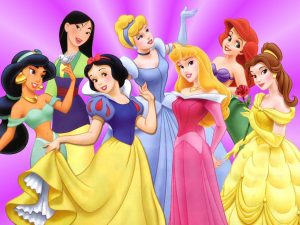Ask any girl who her favorite Disney princess is, and she’ll likely have an answer, along with a detailed explanation. Disney princesses are a ubiquitous part of childhood for millions of girls, but it wasn’t always that way, and it wasn’t even that way very recently. That’s one of the biggest things Peggy Orenstein discovered during the course of writing Cinderella Ate My Daughter, which has recently been released in paperback.
The Disney princesses weren’t a trend until 2000, when Andy Mooney realized that there was an untapped marketing opportunity. Since then, Disney has created over 26,000 princess products – let that sink in. 26,000 princess products from Disney alone.
Disney isn’t the focus of Orenstein’s book, although I’m sure it’s possible to write a book solely on their marketing. Instead, she navigates readers through trying to raise her daughter, Daisy, in a way that didn’t force her into the princess narrative. However, a week after starting preschool, Daisy’s Thomas the Tank Engine toys were at the bottom of the toy box and she could name every Disney princess. Orenstein started to wonder: is it just genetic?
Short answer: No – genes do play a role, sometimes, but the differences among girls and among boys are often much greater than the differences between girls and boys. One of the best things about Orenstein’s book is that it combines developmental psychology with relatable, personal examples, putting them in an accessible framework. For example, kids start self-segregating their play by gender at preschool or kindergarten age. This is a cross-cultural phenomenon. However, this is also the age at which girls’ verbal abilities start to outpace boys’, and boys’ spatial abilities start to outstrip girls’.
 Orenstein talks to researchers who are encouraging cross-sex play without forcing it, or overriding kids’ natural tendencies. Girls who don’t have boy friends and vice versa at that age are less able to relate to one another as they grow up, and these attitudes can become fixed in adulthood. On the flip side, kids who do have cross-sex friendships growing up have longer, more stable relationships as adults. How kids play matters. And it’s easy to help kids play together: all it takes is for teachers to talk about and positively reinforce it.
Orenstein talks to researchers who are encouraging cross-sex play without forcing it, or overriding kids’ natural tendencies. Girls who don’t have boy friends and vice versa at that age are less able to relate to one another as they grow up, and these attitudes can become fixed in adulthood. On the flip side, kids who do have cross-sex friendships growing up have longer, more stable relationships as adults. How kids play matters. And it’s easy to help kids play together: all it takes is for teachers to talk about and positively reinforce it.
Marketing and its effects are another factor in Orenstein’s narrative. Here’s a useful tidbit: kids under 6 cannot tell the difference between TV advertising and programming (and, I would argue, the difference between the two is constantly shrinking). When the annual Toy Fair (a national event that brings in 100,000 products) showcases girls’ toys under a banner reading, “Beautiful, Pretty, Colorful,” and boys’ under a banner reading, “Energy, Heroes, Power,” it’s clear there’s a problem.
One of the most common arguments is that marketers are delivering what kids and parents want – that’s all! Orenstein challenges this notion, asking throughout the book, at what point does a child’s ‘want’ become something that is coerced? When the narrative of advertising starts from birth and delivers the same message to girls constantly, what choice do girls have other than to want what they’re told they want?
Many marketers rely on the argument that they are creating what sells, and responding to a “range” of girls’ play styles. Orenstein retorts that, “Abby [a stereotypically feminized Muppet] would trouble me far less if there could be a female Muppet as surly as Oscar or as id-driven as Cookie or as goofy as Grover: if there were more ‘play patterns’ to ‘honor’ than just this one.” To look at what is offered to girls, the range that marketers insist they’re honoring is nonexistent. When every company offers the same types of toys, in the same colors, with the same rationale, it is apparent that the range is in fact missing. What is being “honored” is a specific idea of what it means to be a young girl. The “old-school stereotypes [are being] recast as the source of liberation rather than an impediment to it.”
This issue becomes a problem for Orenstein in trying to find options for Daisy. As she says, she was trying to offer Daisy more options for exploring her interests and femininity by saying ‘no’ to everything Daisy asked for. Orenstein found a workable method through extra digging, finding more complex storylines to read to Daisy (including Grimm’s fairytales – the chapter on fairytales is especially interesting), focusing frequently on mythology.
 Another great thing about Cinderella Ate My Daughter is that Orenstein isn’t setting out to disparage girlie-girl femininity. There’s nothing wrong with liking princess dresses, ink or romance. But it’s not the only way to be feminine, and Orenstein is concerned that girls are sold short when it’s the only option presented. She also takes a look at what the outcome of total saturation in this type of girlie-girl culture can be.
Another great thing about Cinderella Ate My Daughter is that Orenstein isn’t setting out to disparage girlie-girl femininity. There’s nothing wrong with liking princess dresses, ink or romance. But it’s not the only way to be feminine, and Orenstein is concerned that girls are sold short when it’s the only option presented. She also takes a look at what the outcome of total saturation in this type of girlie-girl culture can be.
The other side of Disney princesses – the Mileys and the Britneys – has a big impact on girls. The Disney girls ride high on a standard of purity-with-a-wink, but oh, how fast they fall once they cast off the image of innocence. She makes a point of deconstructing the virgin-whore dichotomy, and worries about girls whose only access to models of sexuality is to see it made it performance for the approval of onlookers. “The virgin-whore cycle of the pop princesses, like so much of the girlie-girl culture, pushes in the oppose direction [of being able to explore sexuality in a healthy way], encouraging girls to view self-objectification as a feminine rite of passage.”
This, combined with the ‘kids getting older younger’ advertising trend, creates a confusing environment for girls. They are bombarded with messages that tell them they must act (or look like they act) older than their age, and perform the budding sexuality of their bodies, but not given an opportunity to grow naturally into a healthy sexuality that can be safely expressed.
Girls who are ushered into a performance of eroticism at young ages “do not – and may never – learn to connect their performance to erotic feelings or intimacy. They learn how to act desirable but not how to desire, undermining rather than promoting healthy sexuality.” That is the core of the problem with media’s embodiment of girls’ behavior, specifically with regards to the manufactured “knowing naïf” Disney stars, and their inevitable downfalls. Orenstein says, “I suspect that you cannot commodify a girl’s virginity without, eventually, commodifying what comes after.”
The sexualization of childhood, and the pushing of older behavior at younger and younger ages, is a big topic of discussion at SPARK and many of our sister organizations. Learning to deal with these issues in a productive way requires that parents, educators and even people without kids get on board (as Orenstein confesses at the beginning, she’d been writing about how to raise girls for years before she had Daisy). Whether you’re looking to find tools on dealing with sexualization, raising girls, or just starting to learn what it is, Cinderella Ate My Daughter is an excellent place to start.

Actually, as a little girl I was never really into Disney Princesses. I liked fairies; Rainbow Magic fairies. XD